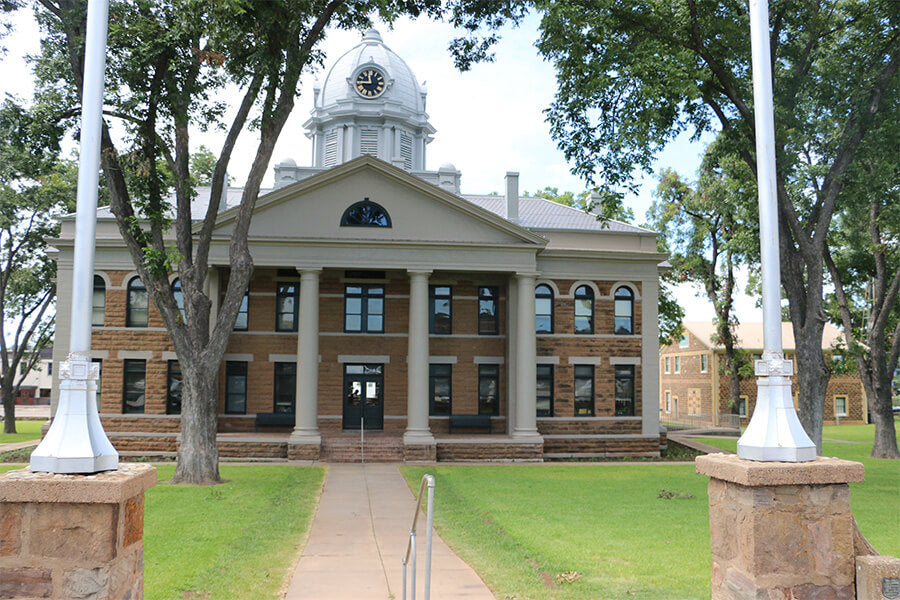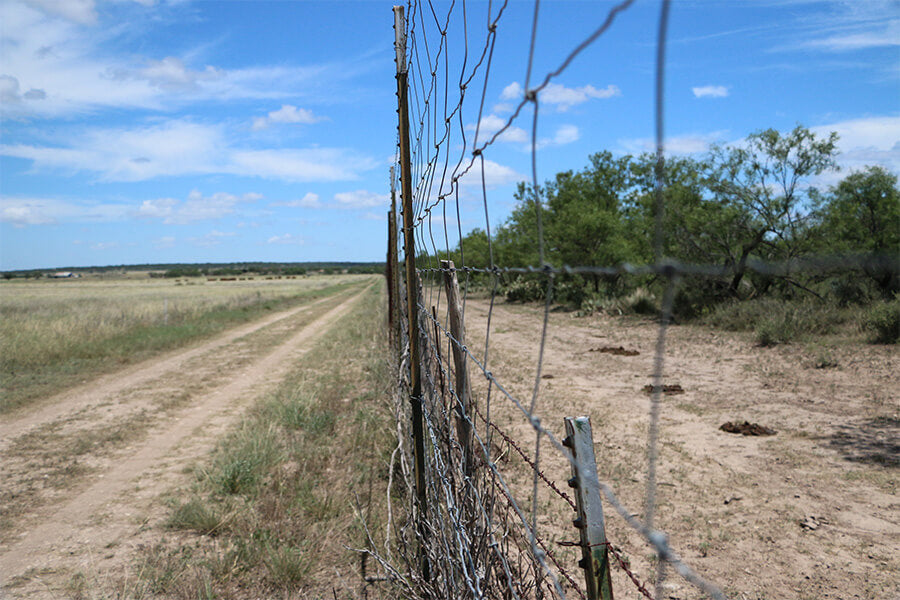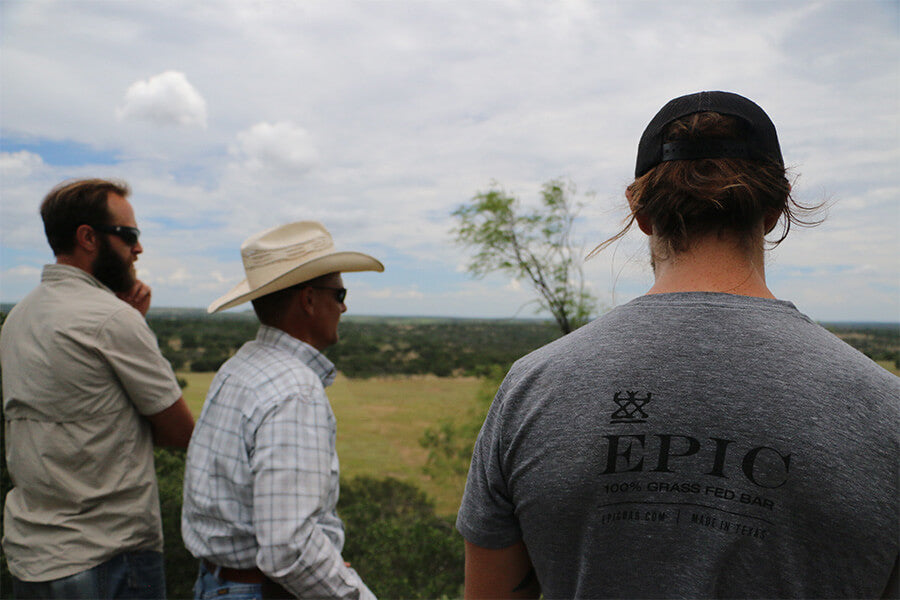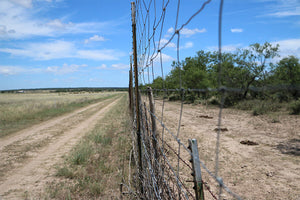Gritty. Tough. Timeless. Ranchers have long made a name for themselves in American folklore as the sturdy embodiment of our country’s rugged roots. Even in the age of smartphones and self-driving cars, their images and land stewardship strategies largely remain unchanged from previous generations. But there’s a fine line between sticking to tradition and falling behind the times. Chad Lemke is looking to change that.
I caught up with Lemke during a recent visit to his ranch out in Mason, Texas. It’s a warm, sunny summer day, and the heat’s bearing down on us as we stand in front of the city’s antique courthouse. Immediately, Chad dives into the building’s history and its deeply-entrenched place in the community’s city square.
“This is actually the third courthouse built here in town, but it’s been standing for over 100 years,” he marvels. “It’s a beautiful building. It really speaks to the heritage and history this town holds.”

Built in 1909, the Mason County Courthouse stands at the center of the tree-lined town square.
Chad’s eyes light up as he talks about the old town. Thanks to its location along the edges of Edward’s Plateau and the Llano Uplift, Mason was once a fort with key high ground. Prior to the Civil War, it was home to decorated soldiers like Robert E. Lee and Albert Sidney Johnston. Nowadays, it’s a rural town of about 2,000 people along SH-71. Lemke is teeming with energy as he plays tour guide for us—which isn’t surprising, considering his family has been ranching in the area for six generations. Sporting a straw cowboy hat, a white shirt with brown and blue plaid patterns, blue jeans, and boots, he definitely looks the part. But Chad’s hardly your average rancher. In fact, he’s kind of a revolutionary around here.
It all started about fifteen years ago. After spending two decades working in landscaping and horticulture in San Antonio, Chad decided to return to his roots and raise livestock. Although his business initially showed promise, he had a life-changing experience after the auction sale of a group of cattle. “I had raised some of the best Hereford heifers I’d ever seen. I thought I was going to make out like a bandit there,” Lemke says. “Instead, I got my butt kicked—everything sold for over $100 less per head than I was expecting. I decided then and there to find a better way than conventional agriculture.”
Reeling with disbelief, he returned home to Mason to regroup. As he drove along the land he grew up playing on, Chad realized something: everything around him was dying. Grassy pastures had been replaced by arid patches of dirt. Destructive plant species like prickly pear cacti, mesquite, and cedar trees had invaded and were syphoning water away from previously healthy plots of land. It was shocking. Determined to save his family’s lands, Lemke discovered the concept of holistic land management—an agricultural planning system that helps land stewards better manage natural resources in order to reap sustainable environmental, economic, and social benefits. In other words, it’s the best way to get the most out of your land over the long haul. Perhaps more importantly, it can also heal previously damaged, over-farmed areas.

This aerial view shows how effective animal impact can be. The left side has been regeneratively farmed, while the right side has not.
Chad couldn’t believe his ears. Holistic ranching sounded promising, but it contrasted so much of what he’d learned growing up. Rather than taking the typical short-term approach to land management, it harnesses ruminants’ (cows, goats, sheep, bison) distinct abilities to naturally fertilize and aerate soils. This requires keeping animals in close quarters and shifting them around mapped-out segments on your property. It also emphasizes a long-term approach that argues letting areas ‘rest’ is better than allowing cows to continuously graze them. The result: healthier, better fertilized lands that aren’t over-grazed.
As we make our way to Chad’s land, he points out various markers along the road. It’s part of his daily drive, and he knows it well. “This area was all part of the Great Western Cattle Trail. Thousands of cattle shoulder-to-shoulder as far as you could see,” he says, pointing towards what’s now an endless sea of cedar trees. “Now, it’s largely a model of land degradation.”
It’s a beautiful drive. The road flows smoothly along the rolling hills it’s carved through, starkly contrasting the pastures and trees whizzing by alongside us. Blue skies and thick, white clouds hang above each rise and fall of our path—essentials for any drive through the Texas Hill Country. But we haven’t seen anything yet, Chad tells us. He was right. We take a turn and are suddenly surrounded by pastures of golden grassland gently blowing in the wind. It’s gorgeous. “Welcome to Menard River Farm,” Chad smiles. As I step out of the car to get a better look, he explains how he transformed this plot from a brittle wasteland to a lush, healthy field—without a single drop of irrigated water. “We let the animals do the work. That’s the core principle of holistic land management,” he says matter-of-factly.
It’s brilliant, really. Rather than utilizing industrial agriculture techniques, which rely heavily on machinery and chemicals and strip lands of vital nutrients, Lemke’s chosen to let animals regulate the land. It sounds simple, but many of Chad’s neighbors—and peers in the greater ranching industry—have had trouble adopting these techniques. Unsurprisingly, he is frequently asked why his cows stay bunched together or why there’s so much surrounding grass they’re not allowed to eat. It’s a profession ruled by tradition, after all. “Everyone thought I was crazy, that I was abusing my cows,” Lemke admits. “People couldn’t understand why I wouldn’t let them aimlessly roam or eat the tall grass nearby.”

Cattle graze in the pastures of Menard River Farm.
But results don’t lie. As the years have passed, it’s become increasingly evident that whatever Chad is doing is working. Now, he wants to spread the knowledge he’s gained over years of experimentation to help other ranchers see the light. In doing so, he believes he’ll not only set up a brighter future for Mason—they’ll also able to chart a better course for suffering lands and the animals that inhabit them. In turn, he hopes to penetrate the growing consumer market for high-quality, grass-fed beef that’s sweeping the nation. There’s a ton of potential for him here, including as a potential supplier for EPIC’s 100% grass-fed beef products. In fact, Chad and his partners could become the first Texas beef producers in EPIC’s network of regenerative suppliers if things continue to progress. “We’ve got a long way to go, but things are getting better and better,” he says. “We’re going to prove that regenerative, grass-fed meat has scientific merit and teeth for the marketplace.”
The wheels are already in motion here. Chad and his partner, Don Davis—along with their wives, Rhona and Debbie—just opened Texas’ first Savory Institute hub: the Grass-fed Sustainability Group. It’s a huge deal. Now, they’re working to pool their resources with other dedicated ranchers in the area to promote grass-fed meats—a move that should give them some serious reach in the greater meat industry. Making this happen will require getting others to buy into the holistic model, but he’s got an ace in the hole. With Savory’s support and EPIC’s sponsorship, they are turning their ranches into research centers that will track land regeneration and growth. Over time, this metrically-driven approach will leave little room for doubters or naysayers.

EPIC's Head of Sourcing, Kirk Blanchard, Chad Lemke, and EPIC Co-Founder Taylor Collins take in the view from a bluff on Lemke's property.
Chad’s cowboy hat bobs back and forth excitedly as we make our way back into town. Despite its uncertainties, he’s optimistic about the future. And considering the strong rapport he has with our founders—he’s been an incredible resource and ranch consultant for our ongoing design of ROAM Ranch—and the opportunities that lie in front of us, we are too.
“Too often in life, we spend our time fighting back what we don’t want rather than planning for what we do want,” he says. “Healing our damaged lands and keeping our communities together is going to require stepping back and rethinking things, but we’ll make it happen.”
We’re rooting for you, Chad. Let’s regenerate this planet one plot of land at a time.
More information on this operation can be seen at www.mlfarmstexas.com



